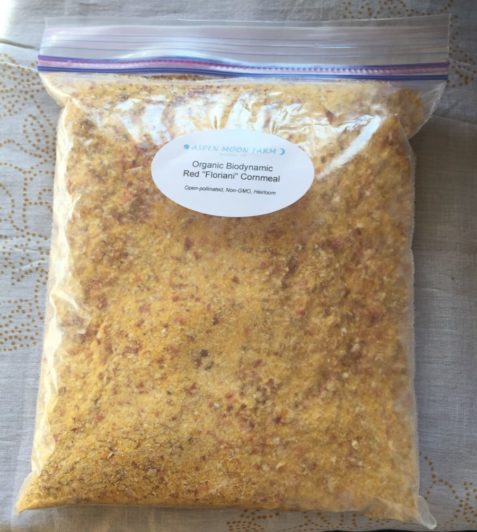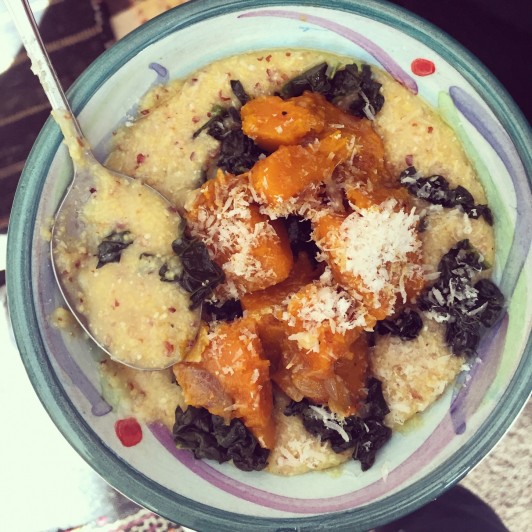One of my favorite dishes to make in winter is polenta. It’s hearty and warm and heats the inner fires. I found a great local source from Aspen Moon Farms in Hygiene, Colorado called, Organic Biodynamic Red “Floriani” Cornmeal. It has a rich yellow color with red flecks inside. It’s open-pollinated, non-GMO, and heirloom..out of Italy, which is why it is also great for making polenta, not just cornbread. For those who may or may not know, the Italians use “flint”corn for their polenta, which I recently learned is the same as native American calico corn, which surprised me. Each kernel has a hard outer layer to protect the soft endosperm, it is likened to being hard as flint; hence the name.
Here we have an Italian variety, named Floriani, for something that was originally ours, grown by the Pawnee Indians a 1000 years ago. This tells me that the Italians were better at appreciating a rustic, heirloom variety and keeping their tradition alive, especially in the popular Alpine polenta eating mountains in the north, more than we Americans were.
This is to say that polenta, with a drizzle of extra virgin olive oil and parmigiano reggiano, make a delectable manage-a-trois. The addition of cavalo nero, and Italian version of flat-leafed kale, and chunks of deep orange Hokkaido or Kabucha squash, makes this dish a winter winner.
Up until about 5 years ago, cavolo nero (black cabbage, dinosaur kale) was not grown out of Tuscany, where it graced almost every garden in the countryside. It was mostly used for Ribbollita, the Tuscan vegetable bread soup, or fetunta, toasted bread rubbed with garlic with a mess of cooked cavolo nero on top, drizzled with pot liquor and extra virgin olive oil. It still graces Tuscan gardens, but now, all across America as well. It’s tall stalk and sky reaching leaves look more like a brussel sprout plant or tobacco. Like most hearty winter greens, it needs a frost to sweeten the bitter flavor. Yet, sauteed with garlic and olive oil, cavalo nero is a dandy dressed up peasant.
Hokkaido or kabucha is a naturally sweet, orange fleshed winter pumpkin from the Hokkaido prefecture of Japan. What sets it apart from other pumpkins is it’s sweet, satisfying nutty taste and texture, especially when baked or made into a pureed soup. Our American orange pumpkins are not naturally sweet and take a lot of sugar to be so. Hence, we eat pumpkin pie and rarely eat it in a savory dish.
Here is the recipe in three parts:

Polenta
1 cups of course cornmeal, preferably a variety best used for polenta
4-8 cups of salted boiling water
butter or olive oil to flavor. This can be corrected to taste at the end of the dish as well.
1/2 cup of grated parmigiano reggiano + more for garnishing the top.
Salt to taste (but at least 1/4 t to start).
Add cornmeal to the simmering water with a whisk so it doesn’t clump. Keep stirring intermittently for at least a half hour. Add more water if necessary to keep it moist and still able to stir. It will be thick. Make sure it doesn’t pop out on you. Stir with a long spoon. It needs to cook a long time to be most delicious. Keep letting it simmer if you aren’t sure. Some people let it cook slowly for an hour. Don’t be surprised if it forms a film on the bottom of the pot. Don’t worry, this is good. It will soak out later and this keeps the polenta from burning. Check for salt. When it’s cooked to the desired consistency, able to keep your wooden spoon almost standing up, add more olive oil (or butter to taste) and a grated parmigiano. Dish into bowls as is, with a drizzle of extra virgin olive oil and a sprinkle or two of good parmigiano. This manage a trois is enough as it is.. or add sauteed cavolo nero and squash.
Sauteed Cavolo Nero
1 bunch dinosaur kale (cavolo nero), chopped coursely
3 cloves of garlic, chopped
1/2 dry red pepper, chopped
Ex. virgin olive oil
Clean the greens and separate the leaves from the stems. Chop course and set aside for a moment. Add ex virgin olive oil, garlic and pepper. Put the greens in straightaway and saute. Add a pinch of salt and cover for 5-10 minutes, stirring occasionally. Cook to your desired tenderness.
Braised Hokkaido pumpkin
1 half of a pumpkin
2 shallots, sliced fine
Cut the green skin away from the flesh of the pumpkin. Remove the seeds. Chop into bite sized cubes. Saute’ shallots in extra virgin olive oil and add the cubed pumpkin to saute together. Add a little water to braise. Stir often checking for a small amount of saucy liquid. Salt to taste.
Add greens and squash to a bowl of polenta, sprinkled with grated parmigiano and a drizzle of your best extra virgin olive oil.
Enjoy this delicious one dish meal!
—
